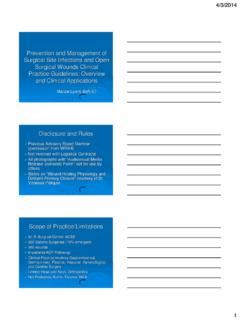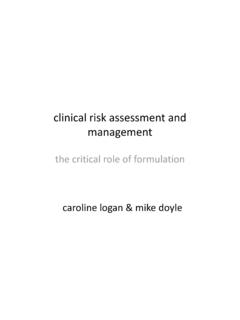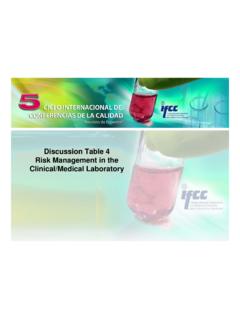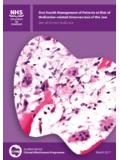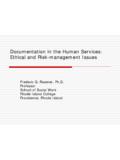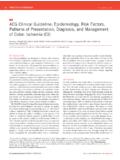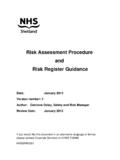Transcription of PAIN ASSESSMENT and MANAGEMENT
1 pain ASSESSMENT and M A NAGEMENTC linical Pr actice Guidelines April 2012 pain AUTHOR REVISION COMMITTEER evision Committee Chairs: Darlene Grantham, clinical Nurse Specialist, Oncology Program, HSC Sarah Brown, clinical Nurse Specialist, Palliative Care Program, WRHAR evision Committee Members: Bruce Anderson, Program Manager, WRHA Surgery and Anesthesia Programs Susan Leonard, Acute pain and Peri-operative Care Nurse, Grace Hospital Shelley Coombes, Acute pain Nurse, Seven Oaks General Hospital Karen Malenchak, Regional Physiotherapy, WRHA Clint Huber, clinical Resource Pharmacist, Pharmacy Program, WRHA Rebecca Neto, Specialist, Primary Care Program, WRHA Pamela Johnston, Nurse Practitioner, Cancer Care Manitoba Pamela Bager, Speech Language Pathologist, WRHA Nina Labun, Regional Manager clinical Services (CNS)
2 , Revera Carole Hamel, clinical Nurse Specialist, Riverview Health Centre Karen Nelson, Acute pain and Anesthesia Nurse Clinician, Concordia Hospital Tamara Wells, Nurse Clinician, pain Clinic, Pan Am Clinic Coleen Weppler, Acute pain Nurse Clinician, Child Health Program Brian Penner, Acute pain Service Nurse, St. Boniface Hospital Judy Robertson, clinical Nurse Specialist, WRHA PCH Program Lori Embleton, Program Director, Palliative Care Program, WRHA Caroline Dekeyster, Chief Nursing Officer, Misericordia Health Centre Kathleen Klaasen, Manager of Nursing Initiatives, WRHA Kim Jabusch, clinical Nurse Specialist, St. Boniface HospitalAdvisory Committee Members: Dr.
3 Mike Harlos, Medical Director, Palliative Care Program, WRHA Dr. Paul Daeninck, Medical Oncologist, Chair pain & Symptom Disease Site Group Dr. Joel Loiselle, Anesthesiologist, Director Acute pain Services, Palliative Care/Chronic pain Consultant Dr. David Strang, Chief Medical Officer, Deer Lodge Centre, Medical Director, WRHA PCH Program, Acting Medical Director, Geriatrics, WRHA Rehab/Geriatrics Program Dr. David Lambert, Staff Pediatric Anesthesiologist Winnipeg Children s Hospital Director of Pediatric Acute pain Services, Pediatric Palliative Care Rhonda Fusee, Program Support Manager, Pharmacy, St. Boniface Hospital Lindsay Filz, clinical Pharmacist, St Boniface Hospital Matthew Bailly, Department of clinical Health Psychology, University of Manitoba School of Medicine Tim Frymire, Coordinator of Spiritual Care, Riverview Health Centre Lisa Demczuk, Librarian, Victoria General Hospital, University of ManitobaNational Reviewer: Dr.
4 G. Vargas-Schaffer, Associate Professor at the Anaesthesiology Department of University of Montreal, Anaestheiologist and pain MANAGEMENT Consultant at the Hotel-Dieu du CHUM Hospital. These guidelines are produced and published by the Winnipeg Regional Health Authority. These guidelines may be reproduced, in whole or in part, provided the source is cited. Winnipeg Regional Health Authority 2012 ContentsTABLE OF CONTENTSI ntroduction .. 1 Background .. 1 Scope .. 1 Goals/Guiding Principles .. 1 Glossary of Terms .. 2 Evidence .. 6 Recommendations .. 7 Part A - pain ASSESSMENT .. 7 Part B - pain MANAGEMENT .. 10 Evaluation and Monitoring.
5 18 References .. 19 Appendices .. 201 IntroductionINTRODUCTIONThe pain ASSESSMENT and MANAGEMENT clinical Practice Guideline (CPG) is a tool that has been developed by regional pain experts and provides specific evidence-informed recommendations to assist health care providers in conducting high quality patient pain assessments that will lead to effective pain MANAGEMENT . BACKGROUNDIn October 2010 a committee of health care professionals with expertise in clinical practice and research in pain ASSESSMENT and MANAGEMENT from the acute care, personal care, palliative care, oncology and long term care sectors, convened to revise the WRHA pain ASSESSMENT and MANAGEMENT clinical Practice Guideline (November 2008 version).
6 This committee reviewed recent pain literature and clinical practice guidelines. The committee decided to adopt the Registered Nurses Association of Ontario (RNAO) updated ASSESSMENT and MANAGEMENT of pain 2007 guidelines (RNAO, 2007) as well as incorporate the most recent evidence-informed and valid ASSESSMENT documentation clinical practice guideline is intended to guide ASSESSMENT and MANAGEMENT of pain within the WRHA. To provide regional guidelines for pain ASSESSMENT and MANAGEMENT based on current evidence and expert opinion. To ensure pain ASSESSMENT and MANAGEMENT is prompt, appropriate and consistent. To ensure pain ASSESSMENT includes the use of systematic and validated tool(s).
7 To promote continual monitoring and improvement in patient outcomes in pain MANAGEMENT . To provide the foundation upon which health care provider education should be To provide regional guidelines for pain ASSESSMENT and MANAGEMENT based on current evidence and expert opinion. To ensure pain ASSESSMENT and MANAGEMENT is prompt, appropriate and consistent. To ensure pain ASSESSMENT includes the use of systematic and validated tool(s). To promote continual monitoring and improvement in patient outcomes in pain MANAGEMENT . To provide the foundation upon which health care provider education should be PRINCIPLES Effective pain ASSESSMENT and MANAGEMENT requires coordinated interdisciplinary intervention in collaboration with patients and their families.
8 Patients have the right to appropriate ASSESSMENT and MANAGEMENT of pain . Unrelieved pain has consequences and should be prevented where possible. Unrelieved pain requires urgent treatment. pain is a subjective, multidimensional and highly variable experience for everyone, and requires a critical analysis of pain -related factors and interventions. A multi-modal treatment approach that includes pharmacological and non-pharmacological interventions is recommended. Health care providers are professionally and ethically obligated to advocate for change in the treatment plan when pain relief is inadequate. Ongoing education is essential to maintain clinical competency in pain ASSESSMENT and MANAGEMENT .
9 Health care providers must advocate for policy change and resource allocation that support effective pain MANAGEMENT to improve a patient s quality of life and reduce their OF TERMSA berrant Dependence (AKA psychological dependence or addiction)Displaying aberrant use of medication, causes can include: pseudoaddiction, addiction, diversion, inadequate understanding or instruction or chemical coping. Acute pain The normal, predictable, appropriate response to a noxious stimulus or disease process that threatens or produces tissue injury, and that abates following remission of the stimulus or healing of the a chronic disease of brain reward, motivation, memory and related circuitry.
10 Dysfunction in these circuits leads to characteristic biological, psychological, social and spiritual manifestations. This is reflected in an individual pathologically pursuing reward and/or relief by substance use and other behaviors. Addiction is characterized by an inability to consistently abstain, impairment in behavioral control, craving, diminished recognition of significant problems with one s behaviors and interpersonal relationships, and a dysfunctional emotional response. Like other chronic diseases, addiction often involves cycles of relapse and remission. Without treatment or engagement in recovery activities, addiction is progressive and can result in disability or premature Co-Analgesics Nonopioid medications that enhance the analgesia provided by analgesics through mechanisms aimed at the source of transmission of pain , resulting in better pain control and/or fewer adverse effects than treatment with analgesics alone.
